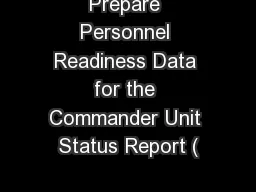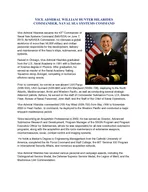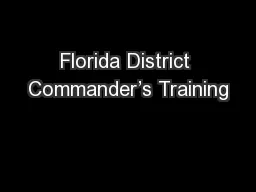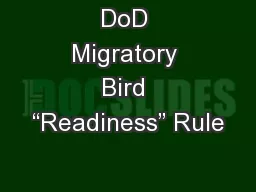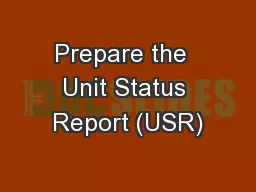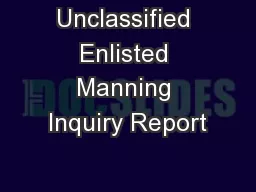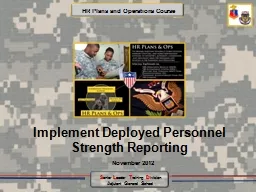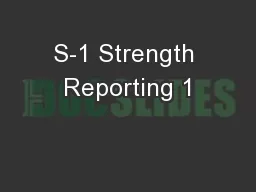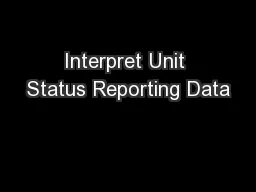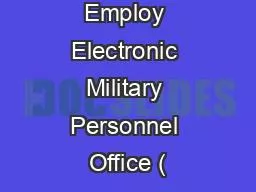PPT-Prepare Personnel Readiness Data for the Commander Unit Status Report (
Author : faustina-dinatale | Published Date : 2018-09-19
USR Adjutant General School BOLCB July 2016 LESSON OUTCOME This lesson provides information on personnel and medical readiness transformation HQDA reporting policies
Presentation Embed Code
Download Presentation
Download Presentation The PPT/PDF document "Prepare Personnel Readiness Data for the..." is the property of its rightful owner. Permission is granted to download and print the materials on this website for personal, non-commercial use only, and to display it on your personal computer provided you do not modify the materials and that you retain all copyright notices contained in the materials. By downloading content from our website, you accept the terms of this agreement.
Prepare Personnel Readiness Data for the Commander Unit Status Report (: Transcript
USR Adjutant General School BOLCB July 2016 LESSON OUTCOME This lesson provides information on personnel and medical readiness transformation HQDA reporting policies and procedures and preparing USR personnel readiness data At the conclusion of this lesson students are enabled to communicate the redesigned personnel and medical readiness deployablity standards review prepare personnel readiness data for USR and calculate personnellevel PLevel metrics. Also known as human resources the personnel field is the branch of a company that deals with hiring recruitment retention benefits labor contracts and employee management They deal with the human capital of an organization and are critical to the bo Raised in Chicago Vice Admiral Hilarides gradu ated from the US Naval Academy in 1981 with a Bachelor of Science degree in Physics After graduation he served as master of the Naval Academy Sailing Squadron sloop Avenger competing in numerous offsho Florida Sons of The American Legion College System – Course . 6. Course . Instructors. Jim Roberts – . Detachment Assistant Adjutant. Squadron 4 Lakeland. 35 . Years of . Service. Past Detachment Commander. Richard A. Fischer, Ph.D.. U.S. Army Engineer R&D Center, Vicksburg, MS. Significant input from Mr. . Tom . Egeland. , Ret.. Office of the Deputy Assistant Secretary of the Navy (. Environment). Migratory Bird Treaty . January 2018. 1. Personnel and Medical Readiness. Transformation. https://www.dvidshub.net/video/451237/medical-readiness-transformation-training-video-introduction. 2. Learning Objective. Action: . 2. ENLISTED MANNING INQUIRY . REPORT (EMIR) . Reference: MILPERSMAN 1306-108. Used to notify the ISIC, TYCOM, MCA, and PERS-4013 of . SIGNIFICANT. . enlisted manning concerns. . PLAD: COMNAVPERSCOM MILLINGTON TN//PERS4013//. Support. Provide HR. Services. Develop HR. Planning and Operations. Staff Products Using MDMP. Man. The. Force. A. djutant . G. eneral. W. arrant . O. fficer . B. asic . C. ourse. Terminal Learning Objective. Strength Reporting . November. 2012. S. enior. . L. eader. . T. raining. . D. ivision. A. djutant . G. eneral . S. chool. HR Plans and Operations Course. 2. Terminal Learning Objective. Action:. Implement Deployed Personnel Strength Reporting. SITUATION. Upon . graduation from SLC, you are assigned as a . Brigade S-1 NCOIC. . Immediately after signing into the unit, the . CSM. calls you into his office and hands you the following . 11B Strength Report . (PRM). A. djutant. G. eneral. S. chool. . C. aptain. C. areer. C. ourse. April 2016. Task Force Smith. Korea 1950. To stem the North Korea advance, the . U.S. deployed . “Task Force Smith,”. and . Strength Reporting. Senior Leader Training Division. Adjutant General School. HR Plans and Operations . Course. 23 January 2018. FM 1-0, Chapter 3. Personnel Accountability (PA) . is the . by-name. June . 2018. Adjutant General School. Captains Career Course. 1. Terminal Learning Objective. Action. : . Interpret Unit . Status . Reporting Data . Conditions. : . Senior HR Technicians i. n . a classroom environment, given access . . SYFTET. Göteborgs universitet ska skapa en modern, lättanvänd och . effektiv webbmiljö med fokus på användarnas förväntningar.. 1. ETT UNIVERSITET – EN GEMENSAM WEBB. Innehåll som är intressant för de prioriterade målgrupperna samlas på ett ställe till exempel:. eMILPO. ) and . Datastore. Functions. Brigade S-1 Operations Course. Senior Leader Training Division. Adjutant General School. October 2015. Terminal Learning Objective. ACTION: . Employ Electronic Military Personnel Office (.
Download Document
Here is the link to download the presentation.
"Prepare Personnel Readiness Data for the Commander Unit Status Report ("The content belongs to its owner. You may download and print it for personal use, without modification, and keep all copyright notices. By downloading, you agree to these terms.
Related Documents

